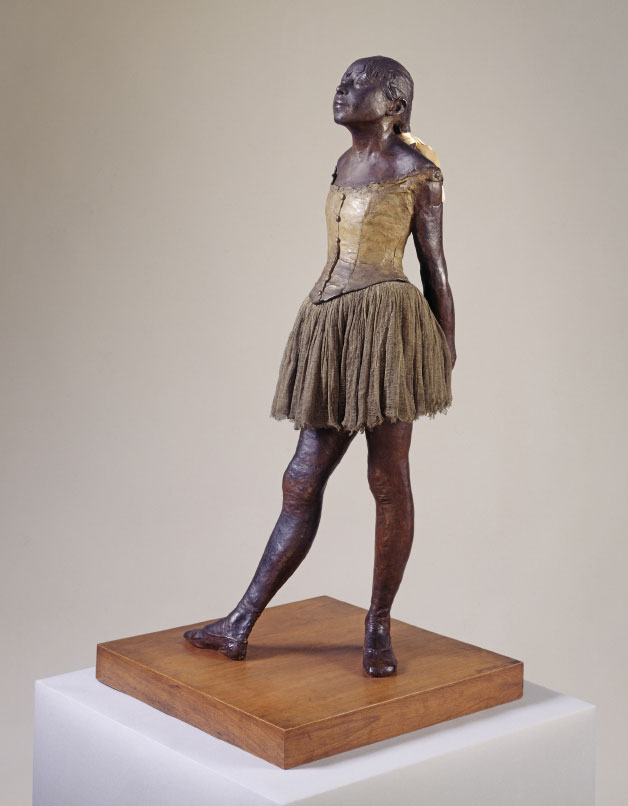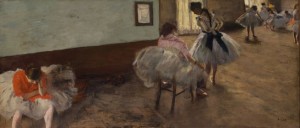The delicate faces, the gossamer-like dresses and the distinctive bold colouring of ballet dancers defines the work of Hilaire-Germain-Edgar Degas. What is less well-known is the artist’s interest in the new technology of photography, which is being explored in a major exhibition at the Royal Academy of Arts called Degas and the Ballet: Picturing Movement.
The landmark exhibition traces the development of the artist’s ballet imagery throughout his career, from the documentary style of the early 1870s to the sensuous expressiveness of his final years. It is the first to present Degas’s progressive engagement with the figure in movement in relation to the advances in photography and early film taking place at the time. The artist was keenly aware of these technological developments and was often directly involved with them. It was this development that gives his works a powerful and interesting perspective.
Thanks to his aristocratic background (his father was a Naples-born banker, his mother a French Creole from New Orleans), Degas was able to explore his own interests in his early life as an artist, which may have contributed to his willingness and ability to innovate. He abandoned his law studies in 1855 to concentrate on his artistic career, travelling widely – to Italy, where he copied scores of works from arts museums and churches, and then on to New Orleans, where he painted wonderful, quotidian scenes of the hustle and bustle of the city.
From 1865 to 1870 he regularly submitted large historical compositions to the French Salon, but in around 1870 he began to concentrate on subjects from modern life, including dance. In 1874 his father died, which uncovered huge debts in the family coffers. As a result Degas was forced to sell his works and then, for the first time in his life, he had to rely on the income from his art.
This might account for his desire to diversify – he joined the group of artists who formed the Société Anonyme des Artistes Peintres Sculptures et Graveurs which aimed to challenged the authority of the powerful Académie. (Other members of the group include Auguste Renoir, Claude Monet and Camille Pissarro.) This led to the first exhibition of artists in the Impressionist movement. Degas disliked this classification although he continued to show his works regularly at their group exhibitions. His work was controlled, and focused on good composition and structure, while Renoir, for example, wanted to depict the fleeting effects of light and atmosphere on landscape and scenes. What united Degas with this group was the preoccupation to depict scenes from modern life.
Degas and the Ballet: Picturing Movement explores the links between Degas’s highly original way of viewing and recording the dance and the inventive experiments being made at the same time in photography by Etienne-Jules Marey and Eadweard Muybridge, and in film-making by such pioneers as the Lumière brothers. By presenting the artist in this context, the exhibition demonstrates that Degas was far more than merely the creator of beautiful images of the ballet, but instead a modern, radical artist who thought profoundly about visual problems and was fully attuned to the technological developments of his time.
So how does this manifest itself in Degas’s work? Think about the best film shots – pans, taken from above and below, close-ups, off-centre images and partial views of some subjects. Key pieces in the exhibition include such masterpieces as the celebrated sculpture Little Dancer Aged Fourteen (1880-81, cast. c.1922, Tate, London), which is displayed with a group of outstanding preparatory drawings that together show the artist tracking around his subject like a cinematic eye.
The Dance Lesson (c. 1879, The National Gallery of Art, Washington, DC) is a wonderful example of the cinematic shot while Dancing Ballerinas highlights the naturalistic view – including a dancer whose face is obscured by her raised aim.
This really is a must-see! If you cannot make it, the Royal Academy has published a sumptuous catalogue to accompany the exhibition by the renowned Degas scholars Richard Kendall and Jill DeVonyar who explore the principal themes of the exhibition.
Further details
The exhibition runs at the Royal Academy of Arts, Piccadilly, London, until Sunday 11 December. Groups of 10 plus are asked to book in advance by telephoning 020 7300 8027, fax 020 7300 8032 or email groupbookings@royalacademy.org.uk




